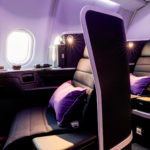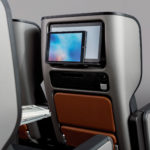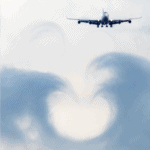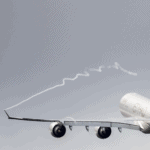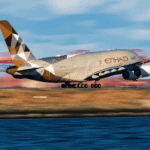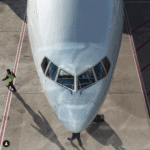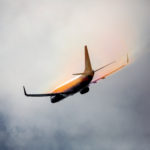Tom Ferguson’s Break in Aircraft Interiors Photography
Share

The interplay of line and curve. The glint of light that hits a surface. The shimmer of sun that peeks past the edge of a window. This is a language all its own, and Tom Ferguson, an architect-turned-photographer is fluent in it.
Tom Ferguson has an unfair advantage when getting behind the lens to photograph private homes, hotels, retail stores and interior-design projects: He had a prior career as an architect. The jump to photographing aircraft interiors, then, wasn’t too daunting. “For me there isn’t a great difference between planes and buildings,” says Ferguson. “It’s all about light, composition and conveying the romance and beauty of the interior while showing the product.”
Photography depends on the presence of light. Sometimes, though, the circumstances of a shoot do not make it easy to satisfy that need. “Photographing the new Qantas economy and premium economy seats for designer David Caon (in 2017) was a new experience for me,” says Ferguson. “It was done in a closed warehouse with very rudimentary lighting, so we had to create an ambience that didn’t exist.”
All photos: Tom Ferguson
Imparting a serene, almost dreamlike feel for the reveal of a new aircraft interior – such as Virgin Australia’s business-class cabin, which Ferguson snapped for tangerine in Wish magazine in November 2015 – is achieved through a complex shoot-and-edit process. “I travel fairly light in these situations, as space is often tight,” he says. To convey an accurate sense of space, Ferguson uses a wide-angle lens, but says it’s important to compose these shots carefully so they don’t feel stretched and make the space feel even smaller. “And there should be things happening in most parts of the frame to engage the eye. I combine wide-angle shots with more intimate details to tell an overall story,” he adds.
“I like to tell the whole story of planes and flight. It’s not just about capturing a shot.” – Tom Ferguson, photographer
Then comes postproduction. While Ferguson strives to get the best possible image in-camera, “there is always color work, some blending of exposures and making sure all my horizontal and vertical lines are straight,” he says, “something I’m obsessed about, having been an architect!” Ferguson batch-processes in Adobe Camera Raw for sharpening and lens correction, and then examines each image individually for color tone and temperature, shadows, highlights and other aspects unique to that particular exposure, that unique moment.
Advances in technology have made Ferguson’s creative process easier. “The two biggest shifts for me have been moving to medium format with the Fujifilm GFX 50S, and to a lesser extent using a Microsoft Surface Pro mounted to a tripod to directly tether for image review on the go,” he says. “Tech shifts make things easier, though your computer hardware has to keep up with the increasing demands and file sizes.”
Photographing aircraft interiors is a dream for Ferguson, whose passion for planes began as a kid when he and his dad would spend weekend afternoons at Sydney Airport watching planes take off and land. After he became a professional photographer, he returned to the airport with his camera for his own enjoyment, and after collecting years of planespotting photos, started a separate Instagram account to share them with others.
One of those images shows the nose of an American Airlines Boeing 777 parked at Dallas-Fort Worth International Airport. “I love the long shadows and light in this one,” he says. “I like to tell the whole story of planes and flight. It’s not just about capturing a shot.”
All photos: From Tom Ferguson’s plane-spotting Instagram account: @sydneyspotting
“Illuminating Interiors” was originally published in the 10.2 April/May issue of APEX Experience magazine.



